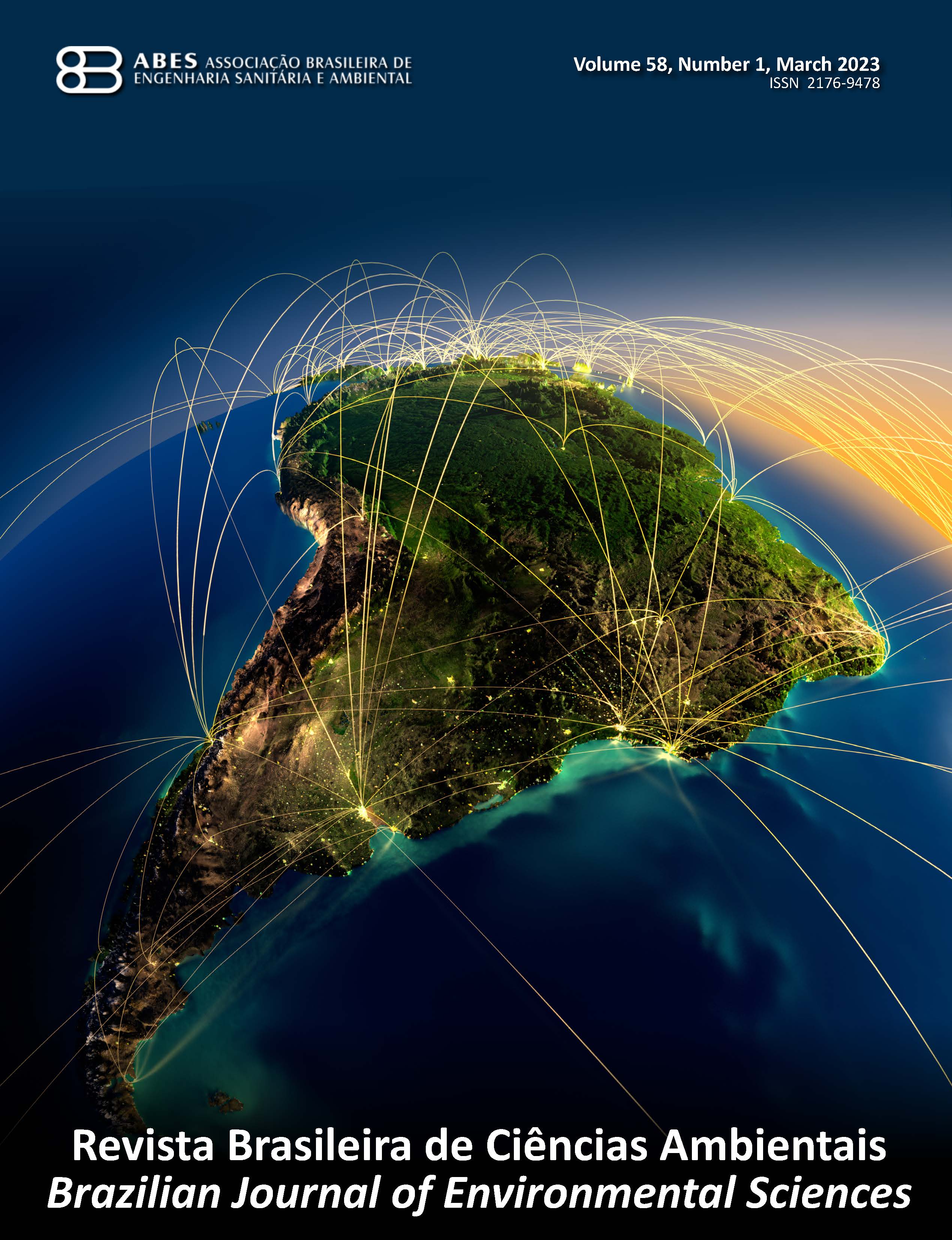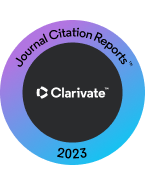Remote sensing applied to biophysical parameters and land cover to identify urban heat islands in Recife (PE), Brazil
DOI:
https://doi.org/10.5327/Z2176-94782107Palavras-chave:
Built-Up Index; índices biofísicos; Google Earth Engine.Resumo
Do crescimento urbanístico resultam diversas alterações relacionadas, principalmente, com aspectos demográficos, sociais, econômicos e ambientais, decorrendo em uma nova conotação no uso e ocupação do solo. Esse novo cenário impacta o balanço energético local, gerando, como é conhecida, uma “ilha de calor urbana”. Esta pesquisa objetiva investigar a ocorrência de ilhas de calor urbana na cidade do Recife, capital de Pernambuco, Brasil, a partir do processamento de parâmetros biofísicos, da classificação do uso e ocupação do solo e da temperatura da superfície. As imagens orbitais da região de estudo foram obtidas e processadas utilizando-se a plataforma de processamento em nuvem Google Earth Engine, para o período de 2013 a 2021. Os resultados evidenciaram a ocorrência de um aumento das áreas com maior densidade urbana e uma redução das áreas com vegetação. Constatou-se que nas regiões com maior densidade urbana, a temperatura de superfície observada foi até 5,20°C mais elevada do que na área com vegetação.
Downloads
Referências
Albuquerque, R.S.; Candeia, B.A.; Tavares Júnior, J.R., Candeias, A.L.B., 2021. Comparison of NDVI and NDBI indices for MUX/IRS/CBERS-4 images with digital number (ND) and monochromatic reflectance (ρ). Journal of Hyperspectral Remote Sensing, v. 11 (1), 73-85. https://doi.org/10.29150/2237-2202.2021.250105.
Allen, R.; Bastiaanssen, W.; Waters, R.; Tasumi, M.; Trezza, R., 2002. Surface energy balance algorithms for land. Advance Training and User’s Manual. version 1.0. University of Idaho, Kimberly, Idaho, USA, 98 p.
Almeida, C.R.; Teodoro, A.C.; Gonçalves, A., 2021. Study of the urban heat island (UHI) using remote sensing data/techniques: a systematic review. Environments, v. 8 (10), 105. https://doi.org/ 10.3390/environments8100105.
Bagyaraj, T.; Senapathi, V.; Karthikeyan, S.; Chung, S.Y.; Khatibi, R.; Nadiri, A.A.; Lajaver, B.A., 2023. A study of urban heat island effects using remote sensing and GIS techniques in Kancheepuram, Tamil Nadu, India. Urban Climate, v. 51, 101597. https://doi.org/10.1016/j.uclim.2023.101597.
Barros, H.R., Lombardo, M.A., 2016. Urban heat island and land use and land cover in São Paulo-SP. GEOUSP Espaço e Tempo (Online), v. 20 (1), 160-177. https://doi.org/10.11606/issn.2179-0892.geousp.2016.97783.
Borges, V.O.; Nascimento, G.C.; Celuppi, M.C.; Lúcio, P.S.; Tejas, G.T.; Gobo, J.P.A., 2022. Local climate zones and Urban Heat Islands: a systematic review. Revista Brasileira de Climatologia, Dourados, v. 31 (8), 98-127. https://doi.org/10.55761/abclima.v31i18.15755.
Cabral, J.J.S.P.; Alencar, A.V., 2005. Recife e a convivência com as águas. In: Hydroaid (Itália), PMSS/Ministério das Cidades (Org.), Gestão do território e manejo integrado das águas urbanas. Brazil-Italy Cooperation in Environmental Sanitation. Ed. Gráfica Brasil, Ministério das Cidades, Brasília, pp. 111-130.
Cheela, V.R.S.; John, M.; Biswas, W.; Sarker, P., 2021. Combating urban heat island effect — a review of reflective pavements and tree shading strategies. Buildings, v. 11 (13), 93. https://doi.org/10.3390/buildings11030093.
Diem, P.K.; Nguyen, C.T.; Diem, N.K.; Diep, N.T.H.; Thao, P.T.B.; Hong, T.G.; Phan, T.N., 2024. Remote sensing for urban heat island research: Progress, current issues, and perspectives. Remote Sensing Applications: Society and Environment, v. 33, 10108. https://doi.org/10.1016/j.rsase.2023.101081.
França, A.F.; Tavares Júnior, J.R.; Moreira Filho, J.C.C., 2012. Índices NDVI, NDWI e NDBI como ferramentas ao mapeamento temático do entorno da lagoa olho d'água, em Jaboatão dos Guararapes-PE. In: Anais do IV Simpósio Brasileiro de Ciências Geodésicas e Tecnologia da Geoinformação [internet]; 2012 May 06-09; Recife, PE: Departamento de Engenharia Cartográfica da Universidade Federal de Pernambuco – UFPE, pp. 01-09 (Accessed March 15, 2024) at:. https://www3.ufpe.br/cgtg/SIMGEOIV/CD/
Gamarra, N.L.R.; Corrêa, M.D.P.; Targino, A.C.D.L., 2014. Use of remote sensing to retrieve surface albedo and land surface temperature in Londrina (Paraná): a contribution to urban heat island studies. Revista Brasileira de Meteorologia, v. 29 (4), 537-550. https://doi.org/10.1590/0102-778620130671.
Gemeda, D.O.; Kenea, G.; Teshome, B.; Daba, G.L.; Argu, W.; Roba, Z.R., 2024. Impact of land use and land cover change on land surface temperature: Comparative studies in four cities in southwestern Ethiopia. Environmental Challenges, v. 16, 101002. https://doi.org/10.1016/j.envc.2024.101002
Google Earth Engine, 2022. Code editor (Accessed September 25, 2022) at:. https://code.earthengine.google.com/
He, C.; Shi, P.; Xie, D.; Zhao, Y., 2010. Improving the normalized difference built-up index to map urban built-up areas using a semi-automatic segmentation approach. Remote Sensing Letters, v. 1 (4), 213-221. https://doi.org/10.1080/01431161.2010.481681.
Huete, A.R., 1988. Adjusting vegetation indices for soil influences. International Agrophysics, v. 4 (4), 367-376.
Instituto Brasileiro de Geografia e Estatística (IBGE), 2022. Cidades e Estados. Recife (Accessed on June 1, 2022) at:. https://www.ibge.gov.br/cidades-e-estados/pe/recife.html.
Igun, E.; Williams, M., 2018. Impact of urban land cover change on land surface temperature. Global Journal of Environmental Science and Management, v. 4 (1), 47-58. https://doi.org/10.22034/gjesm.2018.04.01.005.
Im, J.; Lu, Z.; Rhee, J.; Quackenbush, L.J., 2012. Impervious surface quantification using a synthesis of artificial immune networks and decision/regression trees from multi-sensor data. Remote Sensing of Environment, v. 117, 102-113. https://doi.org/10.1016/j.rse.2011.06.024.
Imran, H.M.; Kala, J.; Ng, A.W.M.; Muthukumaran, S., 2019. Impacts of future urban expansion on urban heat island effects during heatwave events in the city of Melbourne in southeast Australia. Quarterly Journal of the Royal Meteorological Society, v. 145, 2586-2602. https://doi.org/10.1002/qj.3580.
Instituto Nacional de Meteorologia (INMET), 2022. Dados históricos de pluviometria. (Accessed on November 9, 2022) at: https://portal.inmet.gov.br/dadoshistoricos
MapBiomas, 2022. Coleção MapBiomas (Accessed on October 28, 2022) at: https://mapbiomas.org/colecoes-mapbiomas-1?cama_set_language=pt-BR
Mendes, J.V.; Armond, N.B.; Silva, L.C.B., 2022. Urban Heat Islands, heat waves, and cold waves in the municipality of Rio de Janeiro – RJ (2015-2019). Revista Brasileira de Climatologia, Dourados, v. 30, 133-155. https://doi.org/10.55761/abclima.v30i18.14908.
Mendes, T.G.L.; Anjos, R.S.; Santos, T.N.; Moreira, A.B.; Nóbrega, R.S., 2019. Scientific approach on heat islands in Recife-PE. Journal of Environmental Analysis and Progress, v. 04 (1), 001-013. https://doi.org/10.24221/jeap.4.1.2019.2058.001-013.
Moazzam, M.F.U.; Doh, Y.H.; Lee, B.G., 2022. Impact of urbanization on land surface temperature and surface urban heat island using optical remote sensing data: a case study of Jeju Island, Republic of Korea. Building and Environment, v. 222, 109368. https://doi.org/10.1016/j.buildenv.2022.109368.
Peng, S.; Piao, S.; Ciais, P.; Friedlingstein, P.; Ottle, C.; Bréon, F.M.; Nan, H.; Zhou, L.; Myneni, R.B., 2012. Surface urban heat island across 419 global big cities. Environmental Science & Technology, v. 46 (2), 696-703. https://doi.org/10.1021/es2030438.
Rouse, J.W.; Haas, R.H.; Schell, J.A.; Deering, D.W., 1973. Monitoring Vegetation Systems in the Great Plains with ERTS (Earth Resources Technology Satellite). In: Proceedings of 3rd Earth Resources Technology Satellite Symposium [internet]; 1973 December 10-14, Washington DC, USA: Goddard Space Flight Center. [Paper A20], pp. 309- 317 (Accessed April 10, 2024) at:.https://ntrs.nasa.gov/citations/19740022614
Silva, B.B.; Braga, A.C.; Braga, C.C.; Oliveira, L.M.M.; Montenegro, S.M.G.L.; Barbosa Junior, B., 2016. Procedures for calculation of the albedo with OLI-Landsat 8 images: Application to the Brazilian semi-arid. Revista Brasileira de Engenharia Agrícola e Ambiental, v. 20 (1), 3-8. https://doi.org/10.1590/1807-1929/agriambi.v20n1p3-8.
Tariq, A.; Mumtaz, F.; Zeng, X.; Baloch, M.Y.J.; Moazzam, M.F.U., 2022. Spatio-temporal variation of seasonal heat islands mapping of Pakistan during 2000–2019, using day-time and night-time land surface temperatures MODIS and meteorological stations data. Remote Sensing Applications: Society and Environment, v. 27, 100779. https://doi.org/10.1016/j.rsase.2022.100779.
Varshney, A., 2013. Improved NDBI differencing algorithm for built-up regions change detection from remote-sensing data: an automated approach. Remote Sensing Letters, v. 4 (5), 504-512. https://doi.org/10.1080/2150704X.2013.763297.
Venkatraman, S.; Kandasamy, V.; Rajalakshmi, J.; Sabarunisha, B.S.; Sujatha, M., 2024. Assessment of urban heat island using remote sensing and geospatial application: a case study in São Paulo city, Brazil, South America. Journal of South American Earth Sciences, v. 134, 104763. https://doi.org/10.1016/j.jsames.2023.104763.
Ward, K.; Lauf, S.; Kleinschmit, B.; Endlicher, W., 2016. Heat waves and urban heat islands in Europe: A review of relevant drivers. Science of The Total Environment, v. 569-570, 527-539. https://doi.org/10.1016/j.scitotenv.2016.06.119.
Xu, H., 2008. A new index for delineating built-up land features in satellite imagery. International Journal of Remote Sensing, v. 29 (14), 4269-4276. https://doi.org/10.1080/01431160802039957.
Yin, Z.; Liu, Z.; Liu, X.; Zheng, W.; Yin, L., 2023. Urban heat islands and their effects on thermal comfort in the US: New York and New Jersey. Ecological Indicators, v. 154. https://doi.org/10.1016/j.ecolind.2023.110765.
Zha, Y.; Gao, J.; Ni, S., 2003. Use of normalized difference built-up index in automatically mapping urban areas from TM imagery. International Journal of Remote Sensing, v. 24 (3), 583-594. https://doi.org/10.1080/01431160304987.
Downloads
Publicado
Como Citar
Edição
Seção
Licença
Copyright (c) 2024 Revista Brasileira de Ciências Ambientais

Este trabalho está licenciado sob uma licença Creative Commons Attribution 4.0 International License.

























